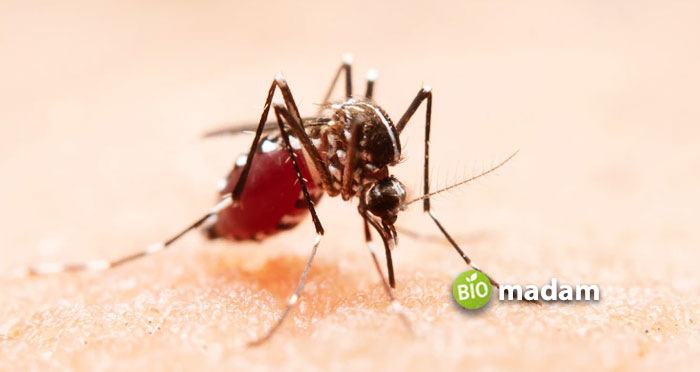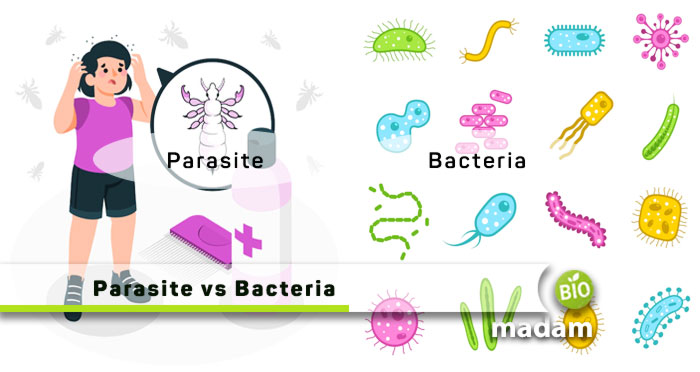Microorganisms are a critical part of our community and ecosystem and are present all around us. Viruses, bacteria, and archaebacteria are among the most common microbes found in ecosystems. Microbes that reside in the body of an organism and harm them are parasites. However, they may or may not cause diseases in some organisms.
Keep reading to understand all the differences between parasites and bacteria.
Comparison Table
| Characteristics | Parasite | Bacteria |
| Definition | Disease-causing organism | Microorganism that may or may not cause disease |
| Types | Protozoa, helminths, and ectoparasites | Bacilli, cocci, and spiral |
| Life Cycle | Growth, reproduction, and transmission | Lag, log, stationary, and death phase. |
| Size | Macro or microscopic | Microscopic |
| Reproduction | Sexual and asexual | Binary fission |
| Need for Host | Yes | No |
| Treatment | Anti-parasitic, antibiotic, or prophylactic treatment | Antibiotics |
| Examples | Flea, tapeworms, pinworms, and leeches | Escherichia coli, Samonella, and Staphylococcus aureus |
What are Parasites?
Parasites are organisms that live in or on the body of a living organism and produce disease. The organism in which the parasite resides is known as the host.
Parasites produce diseases and infections in the organism’s body. They enter the body through contaminated water or food or the bite of an insect. Malaria is an example of the entrance of a parasite into the body through the carrier insect mosquito.
The insects may only be carriers and transmit the disease-causing parasite to another living being. Alternatively, they may act as an intermediate host in which the parasite may produce disease.
Common examples of parasites include protozoans, plasmodium, pinworms, and leeches.

Parasitic Life Cycle
While all parasites do not have exactly the same lifecycle, their life can be divided into three phases: growth, reproduction, and transmission. All bacterial, viral and other pathogenic parasites exhibit these three stages. Some parasites complete their life cycle in one host, while others infect two hosts. Their life cycle is described as either direct or indirect.
Parasites that live in one host have a direct lifecycle. They spend most of their time in one host and move to the other host when the opportunity arises. This stage of their life is known as the free-living stage. This is only possible when the parasites can survive in an environment outside the original host.
The other kind of lifecycle is the indirect life cycle which has two hosts. They do not require living freely in the environment as the intermediate host facilitates their transmission. The parasite develops in the intermediate host and moves to the definite host for reproduction.
Types of Parasites
Hundreds and thousands of different species from genera of microbes and insects act as parasites and carriers for parasites. Yet, parasites are widely classified into three classes: helminths, protozoa, and ectoparasites.
Helminth
Helminths are multicellular eukaryotic organisms visible to the human eye in their maturity stage. They cannot multiply in humans in their adult form. Helminths are not always parasitic, yet many helminths cause diseases in humans. Roundworms, flatworms, and thorny-headed forms are the three classes of Helminth that cause disease in humans.
Protozoan
Protozoans are single-celled, microscopic organisms that might harm the humans by attacking bodily organs. Unlike helminths, protozoans can multiply in humans and may lead to serious infection without needing an intermediate host. Some protozoans live in different body tissues or blood in the human body, while others reside in the small or large intestine. The protozoans causing disease in the human body include Ciliophora, Mastigophora, Sarcodina, and Sporozoa.
Ectoparasites
Ectoparasites refer to organisms that stick to the human skin and harm the body. Besides causing diseases, some arthropod ectoparasites also act as vectors and transmit pathogens, through antigens, to other organisms. Lice, fleas, and ticks are common ectoparasites.
What are Bacteria?
Bacteria are single-celled microscopic organisms that are invisible to the naked eye and exist all around us. They are not only present in our surroundings but also inside our bodies.
Bacteria are typically associated with causing diseases. However, all bacteria are not pathogenic. Some bacteria, known as good bacteria or probiotics, are beneficial to humans. They are also used in the pharma industries to produce medicinal products.

Bacterial Life Cycle
Bacteria grow exponentially when provided with an adequate growth medium. They use inorganic and organic substances and may survive extreme environmental conditions.
The optimal growth conditions for different types of bacteria, like eubacteria and archaebacteria, may vary. Oxygen, nitrogen, temperature, water, and minerals influence bacteria’s life cycle and growth.
The four main stages of a bacterial life cycle include the lag, log, stationary, and death phases.
Lag Phase
The lag phase is the period when the bacteria take their time to adjust to their environment. During this stage, they synthesize amino acids and micronutrients required for division. Once they have all the nutrients for this prokaryotic DNA replication, they proceed to the growth phase.
Log Phase
The second phase of the process is the log phase, in which the bacteria multiply rapidly and may double in 15 minutes. The time for the culture to grow double in size is called ‘generation time.’ Bacterial cells divide into two cells through binary fission. Apart from the quickly replicating bacteria, some may also take days.
Stationary Phase
The stationary phase follows the log phase as the bacteria stop replicating due to lack of space. Yet, the growth may resume when they are moved to another culture with enough space.
Death
When the bacteria have matured, they move towards the death phase. The death of these organisms could be as rapid as their growth.
Types of Bacteria
Bacteria are categorized into various types according to different criteria. They may be categorized into gram-positive and gram-negative based on staining. Alternatively, you may also classify them according to their shapes. These are the types of bacteria according to shape.
Bacilli
Bacilli are generally known as rod-shaped bacteria. They may exist individually or arrange together and are powered with rotating flagella for movement. A pair of two bacilli is known as diplobacilli, whereas a chain of bacilli bacteria is streptobacilli.
Cocci
Cocci bacteria are spherical in shape and remain attached despite forming separate cells. Diplococci are pairs of cocci, whereas streptococci and staphylococci refer to chains and clusters. Moreover, square arrangements of four cocci are called a tetrad, while eight cocci are sarcinae.
Spiral
The third type of bacteria is spiral bacteria which are shaped as spirals or twists. They are either spirochetes (flexible and thin) or spirillums (thick spirals). Vibrios are comma-shaped spiral bacteria with a tiny twist.
Similarities Between Parasites and Bacteria
- They are widespread in our surroundings.
- Bacteria may cause diseases in humans, like parasites.
- Parasites are also often microscopic, like bacteria.
Differences Between Parasites and Bacteria
Definition
Parasite
Parasites are disease-causing organisms that live in or on the host’s body.
Bacteria
At the same time, bacteria are microscopic organisms that may or may not cause disease in humans.
Type of Microorganism
Parasite
Parasites could be prokaryotic or eukaryotic organisms.
Bacteria
Alternatively, bacteria are unicellular prokaryotic organisms.
Function
Parasite
Parasites enter their host’s body to benefit from them and cause harm in return.
Bacteria
Although most bacteria are purposed to cause illness, there are many which are beneficial. So, a bacteria may or may not cause disease. Bacteria called probiotics are beneficial and create a microbiome in the human body.
Types
Parasites
Parasites are categorized into three types according to their function: protozoa, helminths, and ectoparasites.
Bacteria
On the other hand, bacteria are categorized into bacilli, cocci, and spiral based on their shape.
Life Cycle
Parasite
The lifecycle of a parasite could be direct or indirect. It comprises three basic steps: growth, reproduction, and transmission
Bacteria
Alternatively, the bacterial life cycle includes four stages: lag phase, log phase, stationary phase, and death phase.
Size
Parasite
Parasites of different types and vary in size. Some may be visible to the naked eye, while others are microscopic.
Bacteria
Bacteria are microscopic organisms that cannot be seen without a compound or electron microscope.
Reproduction
Parasite
Parasites may exhibit sexual or asexual reproduction.
Bacteria
On the contrary, bacteria multiply through binary fission, which is an asexual mode of reproduction.
Need for Host
Parasite
Parasites require a host to complete their life cycle. Some parasites live in two hosts for different stages of their life.
Bacteria
Bacteria typically do not require a host to survive. However, certain bacteria have disease-producing capabilities in other living beings.
Treatment
Parasite
Treatment of parasitic diseases depends on the type of parasite involved. Thus, it may require anti-parasitic, antibiotic, analgesic or prophylactic treatment.
Bacteria
Bacterial infection often exhibits symptoms early and is treated using antibiotics to inhibit bacterial activity.
Examples
Parasite
Flea, tapeworms, pinworms, and leeches are common parasites.
Bacteria
Examples of bacteria include E. coli, Samonella typhi, Pseudomonas maltophilia, and Sp. aureus.
The Bottom Line
Parasites are disease-causing entities that reside in or on their host’s body to induce disease. On the contrary, bacteria may or may not be parasitic depending on their activities in the body. Some bacteria cause harm to other living beings and are considered parasitic. However, bacteria known as good bacteria are beneficial for our gut health. The main difference between parasites and bacteria is the need for a host. Bacteria do not require a host, whereas parasites may need one or two hosts. You can treat diseases caused by bacteria and parasites through antibiotics and anti-parasite drugs.
FAQs
Are bacteria classified as parasites?
Yes, bacteria may be classified as parasites if they produce disease in another living organism. However, all bacteria are not parasitic. Gut bacteria maintain healthy gut function.
What bacteria is in poop?
Sometimes bacteria and viruses transmit through feces which is a point of concern in stopping transmittance. Salmonella typhi, E. Coli, and Shigella are bacteria found in feces and may be ingested.
Are fungi bacteria?
Fungi are not bacteria as they belong to a different kingdom with unique properties. Fungi belong to the kingdom Fungi, the eukaryotic organisms having a distinct nucleus. Whereas, bacteria are a part of the kingdom Monera.

Hello, I would like to introduce myself to you! I am Chelsea Rogers, an experienced blog writer for science articles, holding an MPhil degree. My enthusiasm to grab the best knowledge, let it relate to botany, zoology, or any other science branch. Read my articles & let me wait for your words s in the comment section.

